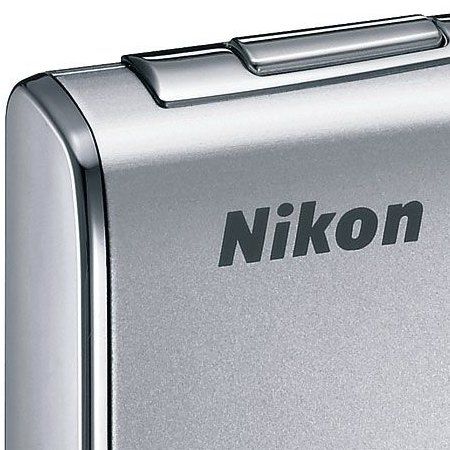The latest stylishly curvatious addition to Nikon’s WiFi enabled pocket snappers is this, the Coolpix S50c comes with a 7.2-megapixel sensor and a range of simple to use features and functions including face detection AF and a decent 38-114mm (35mm equiv.) F/3.3-F/4.2 lens.
Our quick take
There are some issues that tarnish the Coolpix S50c package; AF problems (a common thread on recent Nikon compacts, though not as bad as some recent Coolpix models I’ve reviewed) and the issues over the stunted Wi-Fi functionality are particularly frustrating.
But overall, the Coolpix S50c is easy to use, it looks lovely and it can be relied upon to create some nice shots under the right conditions.
It is replete with nice onboard shooting kit (though it lacks even a modicum of manual controls) and the useful stuff is complemented by a fun interface thanks to that rotary multi-selector.
Not bad then, but not brilliant.

Nikon Coolpix S50c digital camera - 3.5 / 5
| FOR | AGAINST |
|---|---|
|
|
Further improving the camera’s kit list is optical image stabilisation or VR (vibration reduction) that uses active lens elements to help reduce the effects of camera shake by up to three stops of exposure according to Nikon.
And VR is certainly effective as implemented here and allows you to use the camera hand held in lower lighting for example, without having to bump up the ISO setting.
However, you also get a high ISO setting of ISO 1600, and auto-set range of ISO 100 to 800 and manual controls throughout the range (from 100 to 1600 ISO). As is usual low ISO image noise is well controlled but as the settings increase noise increases also: up to ISO 200 its not bad at all, over ISO 400 it’s noticeable while above ISO 800 its very bad. ISO 1600 shots are almost unusable.
The camera comes with a large 3-inch screen the 230k pixel resolution makes it very detailed and nice to use in all but the brightest of conditions where the lack of an optical viewfinder becomes an issue, as with all such cameras.
In terms of the Wi-Fi functionality the S50c is simple to set up and get connected to, say, your home network and this is to be commended. You can upload images to Nikon’s PictureBank site or for emailing via the Coolpix Connect features of the camera. But mysteriously, probably the most useful component of Wi-Fi is not here: the ability to directly shoot and save to a connected PC.
Another issue over the Wi-Fi capability is the camera cannot be connected to wireless hotspots if you’re out, so making the usefulness of the email feature pretty redundant. This reduces the benefit of the WiFi: you are limited to being at home or in your office, where you’ll probably have access to a computer or laptop anyway and, you can connect the camera to a PC directly anyway so ... the cheaper Wi-Fi-less Coolpix S50 might be a better option since it is otherwise identical and you’ll save a few bob in the process.
In terms of control, the camera has the usual shutter release and on/of buttons on the top plate as well as the one touch portrait control (it activates the face detection AF) and the VR activation button.
On the back plate apart from the large screen is a neat rotary multi selector that behaves just like a “normal” four-way jog button but also rotates so that you can quickly navigate through menus or, when in playback, animated rotating thumbs of shot images swirl enjoyably before you. While it takes a little time to get used to this method of control, the rotating selector it is undoubtedly funky and fast to use.
But there are more positives to be had, the Best Shot Selector allows you to snap 10-frames in quick succession, the camera keeping the best/sharpest of the bunch for you. Pressing the anti-shake button on the camera’s top plate activates the triumvirate of BSS, high ISO mode (1600 ISO) and VR but with the caveat on noise problems to the fore.
A good 4cm macro mode provides mediocre close up capability while 15-scene modes provide image presets for thee usual subjects such as portrait, landscape and night scene modes while panorama assist mode provides a previous-image-overlay on the screen to help build a panoramic shot. Other scene settings include sunset and museum modes plus you get a copy function for shooting text documents for example.
In-camera image editing includes cropping and resizing (for email) and Nikon’s excellent D-Lighting mode, this can adjust dark or shaded areas in a shot without adversely affecting highlights. You also get Pictmotion by muvee (sic) that allows you to create slideshows of your images in the camera including transitions and adding background music.
In terms of performance the camera starts up in around one and a half seconds, picture-to-picture timings are around the same (without flash, with flash timings stretch to around 4-seconds). The five-zone AF system is a tad slow in low light where it tends to hunt. In brighter conditions, things improve dramatically but there is marked shutter lag.
The 256-segment metering system works well and I found it to be almost entirely reliable with only some challenging backlit subjects (and there’s a backlit scene mode to use in these circumstances) causing problems.
To recap
Nikon’s latest Wi-Fi digital compactremains stylish and easy to use camera that can produce great shots at lower ISOs
